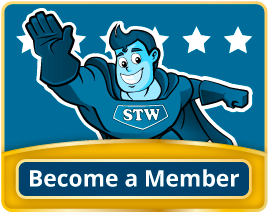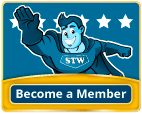2nd Grade Common Core: RI.2.1
Common Core Identifier: RI.2.1 / Grade: 2
Curriculum: Reading Informational: Key Ideas and Details
Detail: Ask and answer such questions as who, what, where, when, why, and how to demonstrate understanding of key details in a text.
47 Common Core State Standards (CCSS) aligned worksheets found:
The Brachiosaurus was one of the largest dinosaurs. It had a long neck and was twice as tall as a giraffe. This plant-eater had no real predators.
Level:
Filing Cabinet
Logged in members can use the Super Teacher Worksheets filing cabinet to save their favorite worksheets.
Quickly access your most used files AND your custom generated worksheets!
Please login to your account or become a member and join our community today to utilize this helpful feature.
Learn all about wild turkeys, including what they eat, where they live, and how they sleep.
(Approx. Grade Levels: 2-4)
(Approx. Grade Levels: 2-4)
Level:
Compare and contrast a vacation at the beach to a vacation in the mountains.
Level:
Did you know that the Velociraptor was a dinosaur that was covered in feathers? Learn all about raptors with this informative article.
Level:
Snakes FREE
Read and learn about snakes with this science poem. Students will enjoy discovering why snakes stick their tongue out as they slither along.
Level:
The Ankylosaurus was a heavy, armored, plant-eating dinosaur from the Late Cretaceous period. It was known for its clubbed tail.
Level:
The Triceratops is very similar to the modern day rhinoceros. They both had large bodies, ate plants, and had horns on their heads. The triceratops was ten feet long and weighed as much as two elephants.
Level:
The Pteranodon was a giant, flying lizard that lived in the late Cretaceous period. It probably ate fish, crabs, squid, and dead animals.
Level:
Learn all about colorful tulips that grow in the springtime.
(Approx. Grade Level: 2-3)
(Approx. Grade Level: 2-3)
Level:
Learn how bananas and pineapples are similar and different.
Level:
Tyrannosaurus Rex FREE
Discover one of the largest and meanest meat-eating dinosaurs. Did you know a t-rex had 60 sharp teeth, and each one is the size of a banana?
Level:
The Spinosaurus was a gigantic meat-eating dinosaur that was even larger than T-rex. It had a crocodile-shaped snout with sharp teeth for eating fish.
Level:
The Stegosaurus was a large, plant-eating dinosaur that lived in the Late Jurassic period. It had large spikes on its tail to fight predators.
Level:
Read the sentences and determine which of the five senses the statement is describing. This worksheet has an outdoor, park-theme. Cut and paste each sense next to the correct statement.
Level:
Your students might be amazed to learn that it can be day all night and night all day in some parts of the world! This nonfiction passage explains how day and night are made.
Level:
Insects have no backbones, three main body parts, and six legs. These three paragraphs and paired questions explore what makes an insect an insect.
Level:
What flower grows more than 15 feet tall, more than a foot wide, and more than 1,000 seeds? Read all about the sun-tracking sunflower in this short article.
Level:
Learn about man's best friend in this short reading comp. Answer questions about mammals and some of dogs' physical traits.
Level:
Learn all about the bat with the misleading name with this engaging article. Accessible text and eye-catching photos help students understand key concepts and answer the reading comprehension questions.
Level:
Summarize the main idea of the book and list interesting facts you've learned.
Level:
Soccer is called football in most countries. It's considered the world's pastime. Read all about it in this fun passage and then answer the questions afterward.
Level:
Why and where do bears hibernate? How do they prepare for hibernation? What do they eat in the spring? Learn all this and more, in this nonfiction hibernation article.
Level:
Print off this worksheet to have students read about the five super senses: sight, hearing, touch, smell, and taste. Then they will answer 4 questions.
Level:
Cut out the five senses and glue each next to the corresponding sentence. The sentences on worksheet have a cooking/kitchen theme.
Level:
This short reading has been tailored for younger kids who are interested in learning about our solar system's star! Read the four paragraphs and then answer the four questions.
Level:
The ostrich lives in Africa, can grow to 9 feet tall, and uses its strong legs to run fast and kick hard. Answer true/false questions and complete a Venn diagram.
Level:
Students choose a dinosaur species and research its size, weight, habitat, and other interesting information.
Level:
Have your students read this short article about owls. Then they will complete the worksheet with two short answer questions and two multiple choice questions.
Level:
The cricket chirps. What do I use to hear the cricket? (ears) The ladybug is red. What do I use to see the ladybug? (eyes) Bees make honey. What do I use to taste the honey? (tongue)
Level:
Have your students complete this book review form each time they've finished a book.
Level:
Young learners can independently read and answer questions about different types of libraries and all sorts of cool things you can use them for.
Level:
Can birds be bald when they don't have hair to begin with? Learn about the color-changing characteristics of this popular eagle, then answer five questions.
Level:
The landscape picture shows mountains, hills, a plain, a river, a plateau, and even a volcano. Students label the picture parts and choose the correct definitions.
Level:
Match each landform picture card with the correct definition card.
Level:
Earthworms have no eyes, no nose, no ears, no bones, no arms, and no legs. They do, however, have very complex bodies.
Level:
This seven-page mini book has fire safety tips. Students can color, assemble, and read the book.
Level:
Cut out the names and pictures of six dinosaurs. Then categorize them into two groups - carnivores and herbivores. Then glue them onto the graphic organizer.
Level:
Match each body of water picture card with the correct definition card.
Level:
Match the landform with the correct definition on this printable worksheet. Vocabulary on this worksheet includes volcano, mountain, hill, canyon, plain, plateau, and others.
Level:
Students use these picture cards to learn about lakes, oceans, harbors, bays, gulf, waterfall, and others.
Level:
Determine which animals are carnivores, which are omnivores, and which are herbivores.
Level:
Does your home have a smoke detector on each level? Does your home have a carbon monoxide detector? Look at the gauges on your fire extinguishers to determine whether or not they are in working order.
Level:
Use these picture cards to make flashcards, decorate a bulletin board, or play a landform game.
Level:
Hibernation is when animals slow down for the winter and fall into a sleep-like state. Learn about animal hibernation with this interesting article.
Level:










